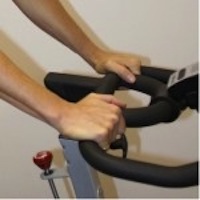A few years ago, Tom Scotto and I did a webinar on hand positions. Last week we posted an Ask the Expert about where to put your hands on an indoor bike when you stand up. This webinar is the perfect visual follow up to that post, covering both seated and standing positions.
The webinar provides the practical and biomechanical reasons for where to place your hands while riding. We cover the reasons why we simulate outdoor riding positions (“keeping it real”)—to a point. We discuss road bike and mountain bike positions, riding seated as well as standing, and why you should not ride in an aero position—even if you are simulating an outdoor triathlete or time-trial position.
Tom discusses how power output can be affected by where you put your hands because it can change which muscles are activated in the hips and how much they are activated. In choosing a hand position, a rider may have to choose between comfort and performance.
One thing Tom and I discuss in the webinar is how hand positions are numbered differently by different programs. What Spinning® labels as position #2 (on the tops of the bars) is position #1 with many other programs. (Note: no other program that I know of advocates placing the hands in the center of the bars over the stem, which is Spinning’s HP #1.)
This is one of the reasons why I personally don’t like to give out position numbers to my riders. Instead, I’ll say something like, “you can put your hands anywhere on the top of the bars here (demonstrate) or move them to the side like this (demonstrate). Feel free to move them around as you want throughout the class—it’s what outdoor cyclists do when they ride in order to prevent numbness or discomfort. Just make sure you aren’t stretched out like this (demonstrate), as that can cause discomfort in the neck, shoulders, or low back.”
We end the webinar with an interesting FAQ where instructors got to ask their questions live on the webinar. If you could have been on this webinar, are there any other questions you would have liked to see answered? Are you ever challenged by riders about where they put their hands? If so, leave your question in the comments and I will answer them!
Click the image to view the webinar.


Good Morning, I have a question I teach on Keiser Bikes and there are handle bars set as normal however there is another set in between the upper part of the handle bars.
Is this safe to use? and an affective way of training? I always encourage riders to ride with elbows out slightly when in a standing climb for the sake of better control and more pull coming from the glutes and utilizing the bars to pull up and use momentum to climb. Hips back and hinged but chest still remains open for air flow. I feel as if there would be no control and restricting air flow as chest is being compressed.
If I’m wrong in my way of thinking can you please advise..
Thank you
The only one “a little off” is Jim……. Your stuff is always backed with sound indoor and outdoor principles and anyone with any basic understanding of cycling can comprehend.
thanks, Dave!
Let me suggest you keep it simple. Spinning taught me the 3 hand positions. If you are a master instructor, why go against their teaching. I also feel your e book a little OFF, when you suggest it is OK to pedal at 120 RPMS. Maybe this is OK for the elitist, but since we have only a few, 99% of our indoor cyclist are the exercisers class, we follow Cycling Fusion recommendation to keep the speed no higher than 110 RPMS.
This entire post and webinar is about keeping it more simple. No need to number hand positions, no need to prescribe a specific hand position for everyone. You should simply suggest riders move the hands to the sides or bar ends when standing (at any cadence) for more stability, comfort and effectiveness, and for them to not ride in a position that stretches them out.
Simple. It’s more along the lines of what Stages, ICG, and several other indoor cycling programs teach about where to put the hands. In fact, I believe Cycling Fusion teaches what Tom suggests in the webinar…because Tom actually wrote the Cycling Fusion training before he came to work for ICA! 😉
I’m not sure whose teaching you think I am going against? We are following the principles of cycling, as Tom explains so well in this webinar. I was a Spinning MI until 2009, and then I started ICA. As the master instructor for ICA, I follow cycling principles. I love Spinning and always will…but their hand position requirements were not based on real cycling. (Proof: they only “allowed” HP 2.5 a few years ago, where most cyclists ride most of the time.)
Also, I am not sure why you think I suggest 120 rpm in my ebook…I do not, nor have I suggested it in any of my articles. I’ve always used 110 rpm as the ceiling for *most* people. Anyone outside of that range better pull out their racing card and be able to prove they have perfect form and years of experience. Are there riders who can do that? Sure…but it is not for the general indoor cycling population. One exception might be a brief pedal stroke or two or three at the start of a realistic sprint.